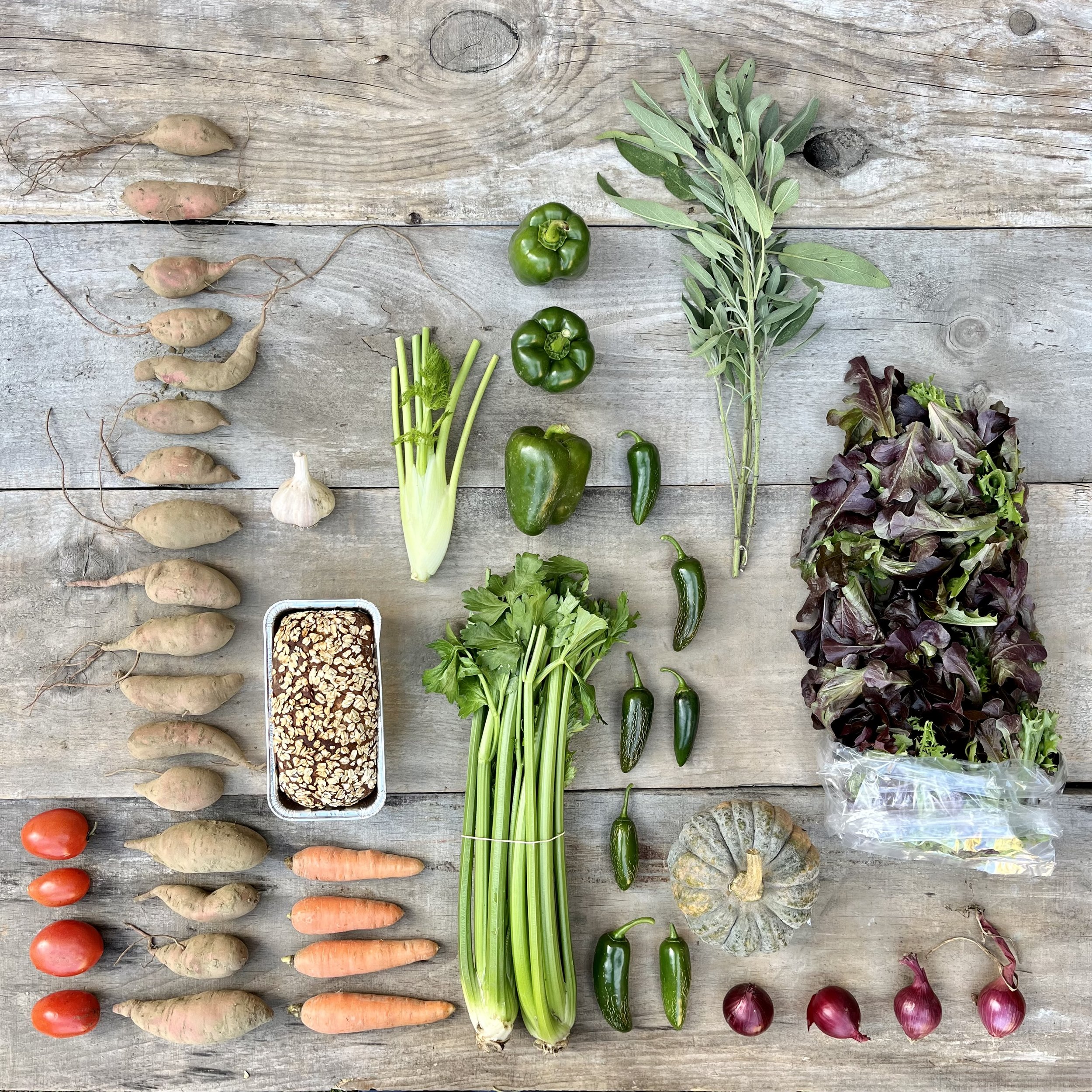P i c k l i s t
GREEN PEPPERS - JALAPENO PEPPERS - CELERY - LETTUCE - FENNEL - CARROTS -
ONIONS - PLUM TOMATOES - SAGE - WINTER SQUASH - SWEET POTATOES
BREAD OF THE WEEK: APPLE CIDER BREAD
THIS WEEK AT EDGEWATER…
Welcome frost! I am shocked at my exclamation and openness to this event, but jeez we are tired and plants are tired. Both fields and humans are ready to button up, cover up, and take a long winter nap. However, pre naptime, there is much to do. Since Friday of last week, we have been busy sweeping the fields of any non frost hardy fruit. This list includes peppers of every variety, tomatoes, lemongrass, etc… the kol crops and carrots can handle a cold snap and often sweeten up with every below 32 degree night, so thankfully there is no hurry on that harvest. But the rest is on go-time as our crew is seasonal and our honey-do list is long. So as soon as frost arrived Tuesday morning, we began to break down the fields: Cut plants, pull drip tape, remove rebar, remove posts, etc… This is absolutely the less glamorous side of farming, but there is a feeling of completion and renewal in this field breakdown and tidying up.
Another area of completion we hit yesterday was the Halloween carving of the very last of the pumpkin crop. It feels good to say, what we did not sell, we carved and stuck a candle in.
As far as other crops go, we have a cooler stacked high with bins full of already harvested beets and carrots, and watermelon radishes. Soon leeks and cabbage and the rest of the carrots will be picked and join the cooler party. Outside the cooler are bins of onions, sweet potatoes, regular potatoes, and we remain beyond fortunate to have greenhouse space to grow greens. All that said, we will not go hungry this winter, and there is always plenty of food for all.
Ok, I need to step away from this computer, put on 10,000 layers of wool, top it off with some fancy neoprene gloves and go finish the CSA pick. I see flurries outside.
FARMY FOODIE PRO-TIPS:
WINTER SQUASH WITH CRISPY SAGE AND HONEY VIA EDEN GRINSHPAN
Winter squash cut into ½ inch thick slices (i keep seeds in!)
15 fresh sage leaves
2 tablespoons honey
2 tablespoons extra virgin olive oil
2 teaspoons kosher salt
½ teaspoon ground pepper
Pre heat oven to 425
On a baking sheet, toss the squash and sage with the olive oil, honey, salt and pepper. Roast until the squash is tender and golden, 20 to 25 minutes, flipping once about halfway through. Serve
Mirepoix Is the Foundation of Stews, Sauces, and More—Here's How to Make It:
The savory combination of celery, onion, and carrots (and sometimes other vegetables) is the silent MVP of so many recipes.
By Victoria Spencer Updated on October 3, 2023
A big bowl of warm, hearty stew is typically full of flavors that go beyond the focal point (think: Beef Stew, Vegetarian Gumbo). If you've ever wondered what makes up the backbone of these liquid-based meals, then it's time to learn about mirepoix, one of the first things chefs learn in culinary school, and the foundation of flavor in so many dishes.
What Is Mirepoix?
A mirepoix is a combination of finely chopped aromatic vegetables that gives a subtle background flavor to dishes such as soups, stews, sauces, and braises. It's a French term that was reportedly devised in the 18th century by the cook to the Duc de Lévis-Mirepoix, a French field Marshal.
The classic mirepoix is made up of onion, carrot, and celery, but this version is only one of many possible variations. Mushrooms, parsnips, leeks, peppers, tomatoes, and garlic are all considered aromatic vegetables and can be used in endless combinations in a mirepoix. Other cuisines have flavor bases allied to the mirepoix:
Soffrito
The Italian soffritto is similar to a mirepoix. Like a mirepoix, it calls for onions, celery, and carrots, and sometimes pancetta and garlic.
The Holy Trinity
The "holy trinity" is used as the base of most soups and stews—including gumbo—in Cajun and Creole cooking in Louisiana. It includes onions, celery, and—instead of carrot—a bell pepper. Green peppers were substituted because they're easier to grow in southern Louisiana—plus they're delicious. It also differs from a mirepoix because the holy trinity uses equal amounts of each vegetable.
Sofrito
A sofrito is a Spanish flavor base. It is similar to the mirepoix in that it uses finely chopped vegetables but the vegetables used are different: onion, tomatoes, bell peppers, and garlic. This sofrito is the base of many recipes including paella, sancocho, and rice-and-bean dishes. A Puerto Rican version of sofrito is known as recaito, and often includes ajíes dulces (small sweet chile peppers). It is used in dishes such as the island's take on arroz con pollo.
How to Make a Mirepoix
For a classic mirepoix, use 2 parts onion to 1 part carrot and 1 part celery.
Rinse, trim, and peel the vegetables.
Chop them into uniform pieces. The shorter the cooking time of your recipe, the smaller the pieces should be, so that they effectively infuse the foods with flavor.
Using a Mirepoix
You can add the mirepoix uncooked to stocks and broths for a light dose of flavor.
To add richness to heartier stews and braises, "sweat" the vegetables first, cooking them with a little oil or butter over low heat until they start to release their juices into the pan.
Recipes that start with a mirepoix are many, from rich French chicken stews and French-style pork stews to those that start with a sofrito, like Spanish-style shellfish dishes. Almost every vegetable soup starts with a mirepoix. Once you know about this flavor base, you'll see how ubiquitous it is.
PICKLE YOUR JALAPENOS!!
Store-bought jars of pickled jalapeños are perfectly delicious. But if you feel like doing more work than unscrewing a cap—or if you bought a glut of peppers at the farmers market—you can make quick-pickled jalapeños (or anything) at home too. First, slice your peppers into rounds. There’s no law against using whole jalapeños, but smaller pieces will soak up the brine faster. Bring 1 cup distilled white vinegar, 2 Tbsp. kosher salt, 2 tsp. sugar, up to 2 Tbsp. spices (e.g., peppercorns, coriander seeds, and/or mustard seeds), chopped fresh herbs (like cilantro), and 2 cups water to a boil in a saucepan. You’ll want enough liquid to cover the peppers, so feel free to scale this ratio up or down as needed.
Transfer sliced peppers to clean glass jars and pour over the brine, leaving ½ inch of headspace between the liquid line and the rim. Screw on the lids and let the jars cool before transferring to the fridge. Your pickled jalapeños will be best after 48 hours and last up to two months refrigerated.

